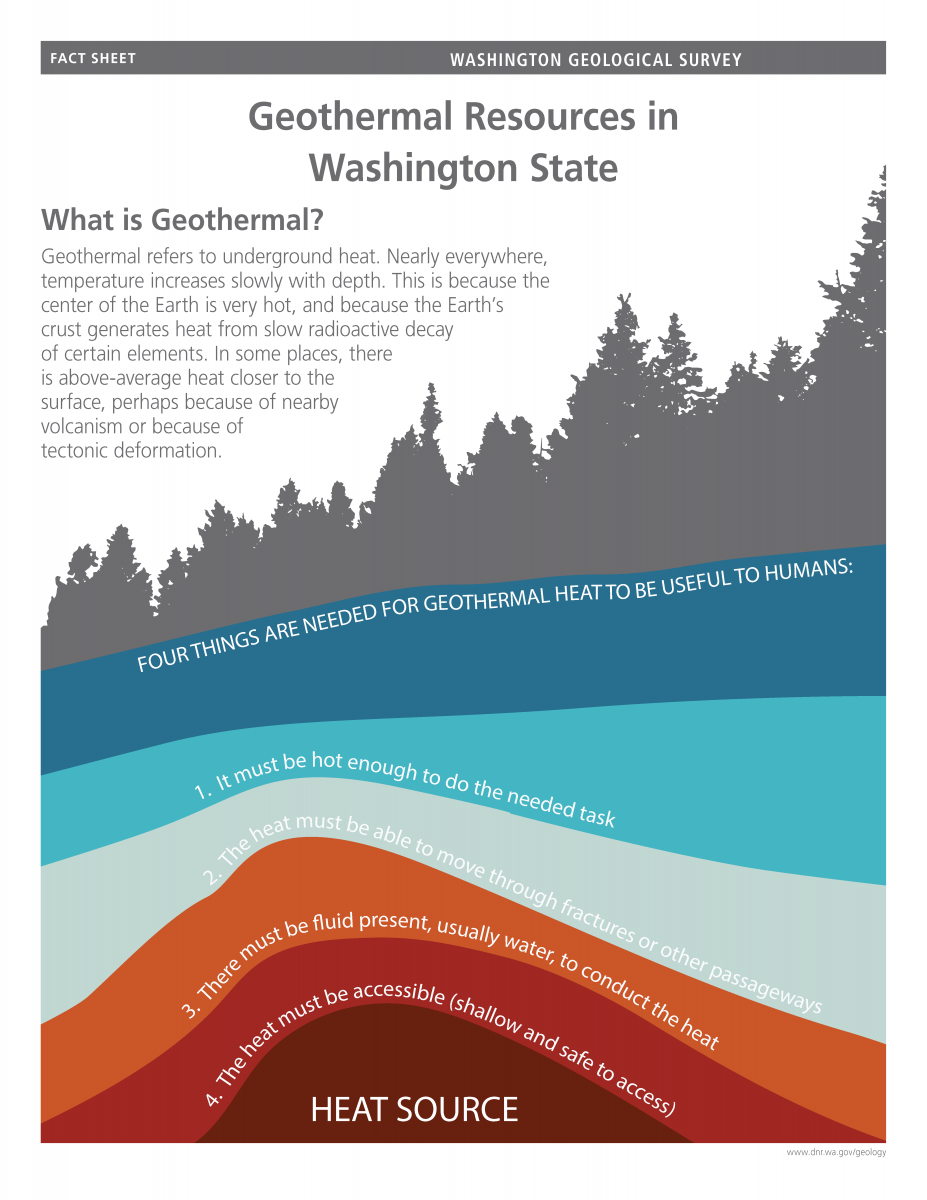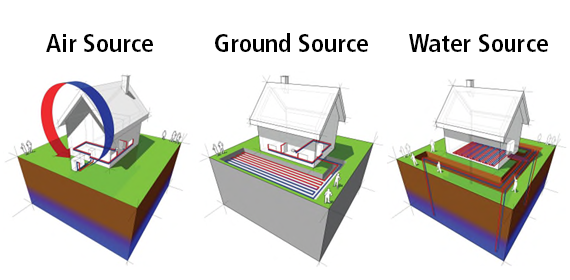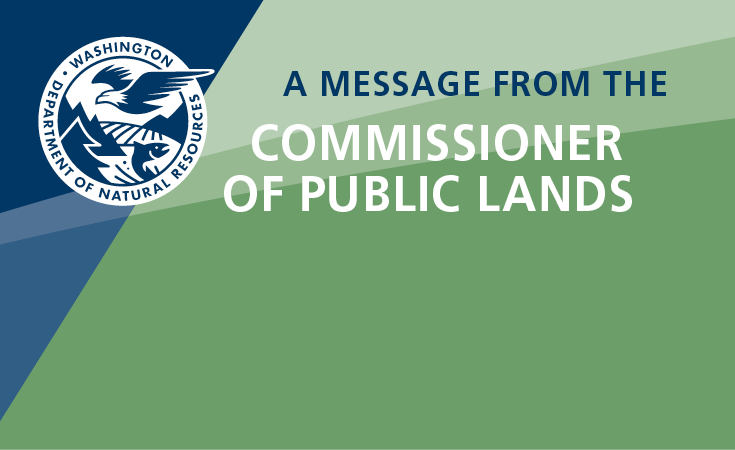Geothermal resources encompass a variety of thermal energy sources that rely on heat stored beneath the Earth’s surface. Geothermal resources are a clean, renewable, and reliable energy source, making them an advantageous replacement for fossil fuels.
At the Washington Geological Survey, we strive to provide useful information to support continued interest in geothermal resources across the State. Our past, current, and future work explores several types of geothermal resources and associated technologies, including:
- Hydrothermal: Using naturally occurring hot water and steam to generate electricity
- Ground-Source Heat Pumps: Using the ground to heat and cool buildings
- Co-generation: Using geothermal systems to improve efficiencies of existing energy infrastructure, for example by capturing waste heat from industrial processes and using it to generate electricity
- Thermal Energy Storage: Using a geothermal system as a battery by pumping hot water into the ground to store energy, then recovering the energy using a geothermal power plant
- Rare Earth Elements: Recovering valuable elements from geothermal fluids
Geothermal resources are poised to play a vital role in shaping a sustainable energy future for Washington State. By integrating technical expertise with an understanding of the social and environmental impacts of these technologies, we can advocate for an energy resource that is equitable for all of Washington.
Geothermal Exploration
Geothermal energy is thermal energy stored in the earth. It has many uses, which are dependent upon the temperature of the resource. Low (<194 degrees F) and moderate temperature (194–302 degrees F) geothermal resources can be used for residential and commercial heating/cooling, or for agriculture. Moderate to high-temperature (>302 degrees F) resources can be used to generate electricity. For more information, see the USGS Fact Sheet.
Power plants can be either binary fluid (Chena Hot Springs, AK) or flash and dry steam power plants (The Geysers, CA).
Much of the higher ground and water temperatures in Washington are the result of magmatic activity associated with the state’s five major stratovolcanoes in the Cascade Range. There is also a large, yet poorly understood area of warm water in the Columbia Basin in eastern Washington.
Many thermal springs are found in high-heat areas. These springs are often aligned with faults. Faults provide pathways for heated fluids to travel from their source to the surface.
It is challenging to find geothermal resources capable of making electricity in Washington State. Most of the heat here is masked by lots of rainfall. These areas are usually also covered by ridiculous amounts of trees. This is not the case in other areas with geothermal potential, like the Basin and Range of Nevada.
We must use things like earthquakes, lidar, geologic mapping, water chemistry, and geophysics to find target areas. In the Cascade Range, there are high elevations, rugged slopes, large amounts of snowfall, and land-use limits in areas of pristine wilderness. These factors make the task even more difficult.

Annual rainfall in Washington State. Yes, that's a maximum of 261 inches (22 feet)!
Data courtesy: © 2015, PRISM Climate group.

Darker shades of green indicate high amounts of tree canopy coverage, making remote-sensing tools like lidar critical for seeing through the evergreen canopy. Image courtesy: Ohmann and Gregory (2002).
Regional studies of heat flow in Washington were undertaken in the 1980s in partnership with Southern Methodist University, consisting of drilling and logging hundreds of wells for temperature and sampling thermal and mineral springs, resulting in GM-25 and OFR 94-11, among many other publications. For a complete listing from those years, see the Bibliography of Geothermal Resources.
After this point, research and interest dwindled. In recent years, however, the Survey received funding from the Department of Energy to compile geothermal data for cataloguing in the National Geothermal Data System (NGDS), a nationwide data catalog of geothermal resource information. Washington participated in this project between 2010 and 2013, generating over 15 relevant datasets, drilling four new temperature-gradient wells, logging 50 holes of opportunity with temperature logging equipment, sampling 87 springs for major element and isotope chemistry, and geologic mapping and ground-based geophysics within 61 square miles of the Wind River valley near Carson, WA. Most of the data gathered is now available both on the Geothermal Resources theme of our Washington Geologic Information Portal and as ArcGIS geodatabase downloads. We have also published the mapping in the Wind River valley (OFR 2014-01).
Once the NGDS project was complete, we used the new data to model Washington State. This work resulted in the Geothermal Favorability Model of Washington State (OFR 2014-02). The results generally agreed with the favorable areas shown in GM-25, highlighting several zones in the Cascade Range as worthy of attention.

Geothermal resource potential map of Washington State.
Current Work

We recently received additional funding from the Department of Energy to further refine the geothermal modeling technique for three locations in the Cascade Range: (1) Mount St. Helens seismic zone, (2) the southeast flank of Mount Baker, and (3) the Wind River valley. We have more detailed data for these areas and they have fewer land-use restrictions.
We are working with partners at AltaRock Energy, BOS Technologies, Temple University, and the U.S. Forest Service. We are also using more advanced techniques to model permeability based on stress and strain parameters in three dimensions. For more information on this project, see the poster we presented at the 2014 Geothermal Resources Council Annual Meeting, or check our our Geothermal Fact Sheet.

Geothermal resource potential map of the Washington Cascade Range, showing the three areas selected for targeted research and several heat input variables.
Geothermal Heat Pumps
Why am I hearing about heat pumps?
Amendments to Washington State Energy Codes will require new homes and buildings to meet revised energy performance standards for heating. These revised standards are motivated by the 2021 State Energy Strategy, which identifies heat pumps as a tool to help decarbonize buildings through increasing energy efficiency and directly cutting carbon emissions.
Federal incentives supporting these new building codes in the form of rebates and tax credits are being made available to Washington residents. More information about these incentives is available through the State Energy Office at the Department of Commerce.
"Buildings are the most rapidly growing source of greenhouse gas emissions in Washington State. While statewide emissions have grown 10 percent overall since 1990, building emissions have jumped by 50 percent, more than any other source in our state."
Governor Jay Inslee, 2019
What are heat pumps?
Heat pumps use electricity to move heat from one place to another. This exchange can use multiple sources (or sinks) of heat, including air, water, or the ground.

Image source: Department of Commerce—2021 State Energy Strategy Appendix D
Ground and water source heat pumps can provide good performance regardless of outdoor air temperatures, making them an advantageous heat pump option for Washington. More information pertaining to water source heat pumps can be obtained from the Department of Ecology.
Geothermal heat pumps
Geothermal heat pumps (also called ground source heat pumps) are heating and cooling systems that use the natural heat stored in the ground to regulate indoor temperatures. They work by extracting heat from the ground in the winter to warm a building, and releasing heat into the ground in the summer to cool it. These systems are highly energy efficient and environmentally friendly, as they rely on the stable temperature of the earth instead of burning fossil fuels.
More geothermal heat pump information can be obtained from the Geothermal Technologies Office at the Department of Energy's Office of Energy Efficiency & Renewable Energy.
Are geothermal heat pumps a good option for Washington residents?
In many cases, yes! Geothermal heat pumps can be a great choice for Washington homes and businesses because:
- Washington has moderate climates with average heating and cooling demands, and stable ground temperatures.
- Geothermal heat pumps are energy-efficient, which can help alleviate Washington's higher than average energy costs.
- Geothermal heat pumps are sustainable and an environmentally friendly alternative to traditional gas or electric heating.
It’s important to know that installing a geothermal heat pump system is not a do-it-yourself project. These systems must be customized based on the heating and cooling requirements, budget, and site characteristics, so you should plan on working with a qualified installer. Specialized technical knowledge and equipment are needed to install a geothermal heat pump system.
The Geothermal Technology Office maintains a webpage on Tax Credits, Incentives, and Technical Assistance for Geothermal Heat Pumps where you can find a geothermal designer or local professional engineer who can help you determine if your property is suitable for a geothermal heat pump installation.






